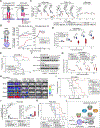Systematic evaluation of GAPs and GEFs identifies a targetable dependency for hematopoietic malignancies
- PMID: 40788260
- PMCID: PMC12427560
- DOI: 10.1158/2159-8290.CD-25-0299
Systematic evaluation of GAPs and GEFs identifies a targetable dependency for hematopoietic malignancies
Abstract
GAPs (GTPase-activating proteins) and GEFs (guanine nucleotide exchange factors) play key roles in cancer development, but their large number and potential redundancy have limited systematic evaluation. Here we perform unbiased genetic screens to identify GAPs and GEFs with cancer- and lineage-specific requirements, as well as dual perturbation screens to dissect functionally relevant interactors of GAPs and GEFs. Application to primary acute myeloid leukemia (AML) patient specimens uncovers the GAP ARHGAP45 as a targetable dependency shared across cancers of hematopoietic origin while being dispensable in normal hematopoiesis. We demonstrate that targeting ARHGAP45-expressing cells can be achieved through TCR-CAR T cells directed at an ARHGAP45-encoded minor histocompatibility antigen and that pharmacologic targeting of GAPs required upon ARHGAP45 depletion augments ARHGAP45-directed cell therapies. These studies provide a resource for probing oncogenic and druggable regulators of GTPases and strategies to target a GAP that represents a shared dependency across blood cancers.
Conflict of interest statement
Competing Interests
The remaining authors declare no competing interests.
Figures







References
Grants and funding
LinkOut - more resources
Full Text Sources
Miscellaneous

